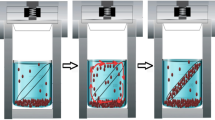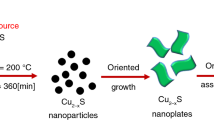Abstract
Shape control of inorganic nanostructures generally requires using surfactants or ligands to passivate certain crystallographic planes. This paper describes a novel additive-free synthesis of cupric oxide nanostructures with different morphologies from the aqueous solutions of copper(II) with Cl−, NO3 −, and SO4 2− as counter ions. Through a one-step approach, CuO nanoleaves, nanoparticles and flower-like microspheres were directly synthesized at 80°C upon exposure to ammonia vapor using a cupric solution as a single precursor. Furthermore, during a two-step process, Cu(OH)2 nanofibers and nanorods were prepared under an ammonia atmosphere, then converted to CuO nanostructures with morphology preservation by heat treatment in air. The as-prepared Cu(OH)2 and CuO nanostructures are characterized using x-ray diffraction, scanning electron microscopy and Fourier transformation infrared spectroscopy techniques.
Similar content being viewed by others
References
A.E. Rakhshani, Solid State Electron. 29, 7 (1986).
J. Liu, J. **, Z. Deng, S.Z. Huang, Z.Y. Hu, L. Wang, C. Wang, L.H. Chen, Y. Li, G. Van Tendeloo, and B.L. Su, J. Colloid Interface Sci. 384, 1 (2012).
K. Zhou, R. Wang, B. Xu, and Y. Li, Nanotechnology 17, 3939 (2006).
A. Chowdhuri, V. Gupta, K. Sreenivas, R. Kumar, S. Mozumdar, and P.K. Patanjali, Appl. Phys. Lett. 84, 1180 (2004).
K. Zhang, Y. Yang, E.Y.B. Pun, and R. Shen, Nanotechnology 21, 235602 (2010).
L. Liao, Z. Zhang, B. Yan, Z. Zheng, Q.L. Bao, T. Wu, C.M. Li, Z.X. Shen, J.X. Zhang, H. Gong, J.C. Li, and T. Yu, Nanotechnology 20, 085203 (2009).
L.B. Chen, N. Liu, C.M. Xu, H.C. Yu, and T.H. Wang, Electrochim. Acta 54, 4198 (2009).
S. Anandan, X. Wen, and S. Yang, Mater. Chem. Phys. 93, 35 (2005).
M. Suleiman, M. Mousa, A. Hussein, B. Hammouti, T.B. Hadda, and I. Warad, J. Mater. Environ. Sci. 4, 792 (2013).
F.M. Al-Marzouki, O.A. Al-Hartomy, and M.A. Shah, Int. J. Manuf. Mater. Mech. Eng. 1, 58 (2011).
X. Chen, H. Cui, P. Liu, and G. Yang, Appl. Phys. Lett. 90, 183118 (2007).
T. Kimura, Y. Sekio, H. Nakamura, T. Siegrist, and A.P. Ramirez, Nat. Mater. 7, 291 (2008).
Z.S. Hong, Y. Cao, and J.F. Deng, Mater. Lett. 52, 34 (2002).
S. Anandan, G.J. Lee, and J.J. Wu, Ultrason. Sonochem. 19, 682 (2012).
D. Son, C. You, and T. Ki, Appl. Surf. Sci. 255, 8794 (2009).
C.L. Carnes, J. Stipp, K.J. Klabunde, and J. Bonevich, Langmuir 18, 1352 (2002).
Y. Lim, J. Choi, and T. Hanrath, J. Nanomater. 2012, 393160 (2012).
H. Wang, J.Z. Xu, J.J. Zhu, and H.Y. Chen, J. Cryst. Growth 244, 88 (2002).
D.P. Volanti, D. Keyson, L.S. Cavalcante, A.Z. Simoes, M.R. Joya, E. Longo, J.A. Varela, P.S. Pizani, and A.G. Souza, J. Alloys Compd. 459, 537 (2008).
M. Mansournia, F. Azizi, and N. Rakhshan, J. Phys. Chem. Solids 80, 91 (2015).
M. Mansournia and A. Hajiebrahimi, J. Mater. Sci. Mater. Electron. 26, 7117 (2015).
M. Mansournia, S. Rafizadeh, and S.M. Hosseinpour-Mashkani, Ceram. Int. 42, 907 (2016).
A. El-Trass, H. El-Shamy, I. El-Mehasseb, and M. El-Kemary, Appl. Surf. Sci. 258, 2997 (2012).
M.A. Das, S.H. Nam, Y.S. Kim, and W.B. Kim, J. Solid State Electrochem. 14, 1719 (2010).
U.W. Schonenberger, J.R. Gunter, and H.R. Oswald, J. Solid State Chem. 3, 190 (1971).
K. Nakamoto, Infrared and Raman Spectra of Inorganic and Coordination Compounds, 5th ed. (New York: Wiley, 1997).
D.P. Singh, A.K. Ojha, and O.N. Srivastava, J. Phys. Chem. C 113, 3409 (2009).
C. Lu, L. Qi, J. Yang, D. Zhang, N. Wu, and J. Ma, J. Phys. Chem. B 108, 17825 (2004).
Acknowledgement
The authors are grateful to University of Kashan for supporting this work by Grant No 256749/7.
Author information
Authors and Affiliations
Corresponding author
Rights and permissions
About this article
Cite this article
Mansournia, M., Arbabi, A. Ammonia Vapor-Assisted Synthesis of Cu(OH)2 and CuO Nanostructures: Anionic (Cl−, NO3 −, SO4 2−) Influence on the Product Morphology. J. Electron. Mater. 46, 502–509 (2017). https://doi.org/10.1007/s11664-016-4910-x
Received:
Accepted:
Published:
Issue Date:
DOI: https://doi.org/10.1007/s11664-016-4910-x




